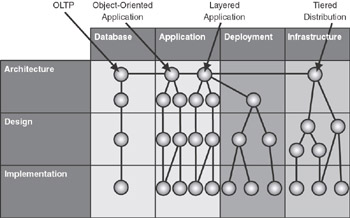Constraints
The Pattern Frame organizes the collection of patterns into meaningful subcategories. For example, you can now focus on the design patterns of the Database view or on the implementation patterns of the Application view.
However, software takes many forms. Today, software operates embedded systems such as pacemakers and telecommunications equipment, real-time systems such as antilock brakes, or in data warehousing systems constructed to analyze consumer buying behavior. Trying to address patterns related to all these flavors of software solutions would quickly enlarge the scope of any single book or pattern repository. ESP, therefore, constrains the patterns to enterprise business solutions. Because this term is somewhat nebulous, ESP identifies a small set of specific top-level architectural patterns, or root patterns, within the pattern graph. All other patterns in this collection adhere to the following constraints:
-
Online transaction processing (OLTP)
-
Object-oriented
-
Layered application
-
Tiered distribution systems
OLTP systems are database subsystems that manage the processing of transactions. These subsystems ensure that each transaction is atomic, consistent, isolated, and durable (the so-called ACID properties). In practice, these applications often manipulate one or more relational databases that maintain the business state of the enterprise. In other words, these are the databases that keep track of the customers, orders, accounting, and so on. By identifying OLTP as a top-level constraint in the Pattern Frame, ESP excludes online analytical processing (OLAP) or simple flat file systems that do not support transactions. The online aspect of OLTP implies that these systems are reading or updating the database immediately in response to a change in business state, which excludes offline batch processing from consideration.
From the application viewpoint, the Pattern Frame is constrained by two patterns: Object-Oriented Application and Layered Application. Most, if not all, of the application viewpoint patterns depend on object-oriented concepts such as encapsulation, polymorphism, and inheritance to successfully resolve their forces. Therefore, the Pattern Frame addresses only object-oriented applications and specifically does not address procedural applications.
Interesting enterprise applications are usually composed of a large number of objects and services that must collaborate to provide something of value to the business. To manage these collaborations, there must exist some high-level organization of the system. Most enterprise class systems use a layered approach to manage this complexity. As a result, the Pattern Frame addresses only applications that are designed as a set of layers and specifically excludes monolithic applications with little or no internal structure.
From the infrastructure viewpoint, the model is constrained to a hardware infrastructure that supports distributing an application over a number of servers arranged into tiers. The tiered approach is commonly used for enterprise applications, because it has a relatively low startup cost and it supports a scaling out strategy where inexpensive servers can be added to the infrastructure to add incremental capability. Excluded from the model are solutions based on deploying applications to a single mainframe or large multiprocessor computer.
The deployment perspective is concerned with bridging the gap across the applications and infrastructure viewpoints. As a consequence, it does not have any constraints of its own, but operates within the constraints set by the application and infrastructure viewpoints. In other words, the highest-level deployment pattern is about mapping layered applications to a tiered distribution infrastructure and does not impose any additional constraints of its own.
Taken as a group, these four high-level constraints, or root constraints, help to narrow the patterns that are in scope for the remainder of this guide. Figure 2.7 shows the root constraints along the top of the Pattern Frame.

Figure 2.7: Root constraints of the PatternFrame
Reducing the scope of the Pattern Frame makes it possible to focus on specific patterns and the relationships between them in more relevant detail.
EAN: N/A
Pages: 107